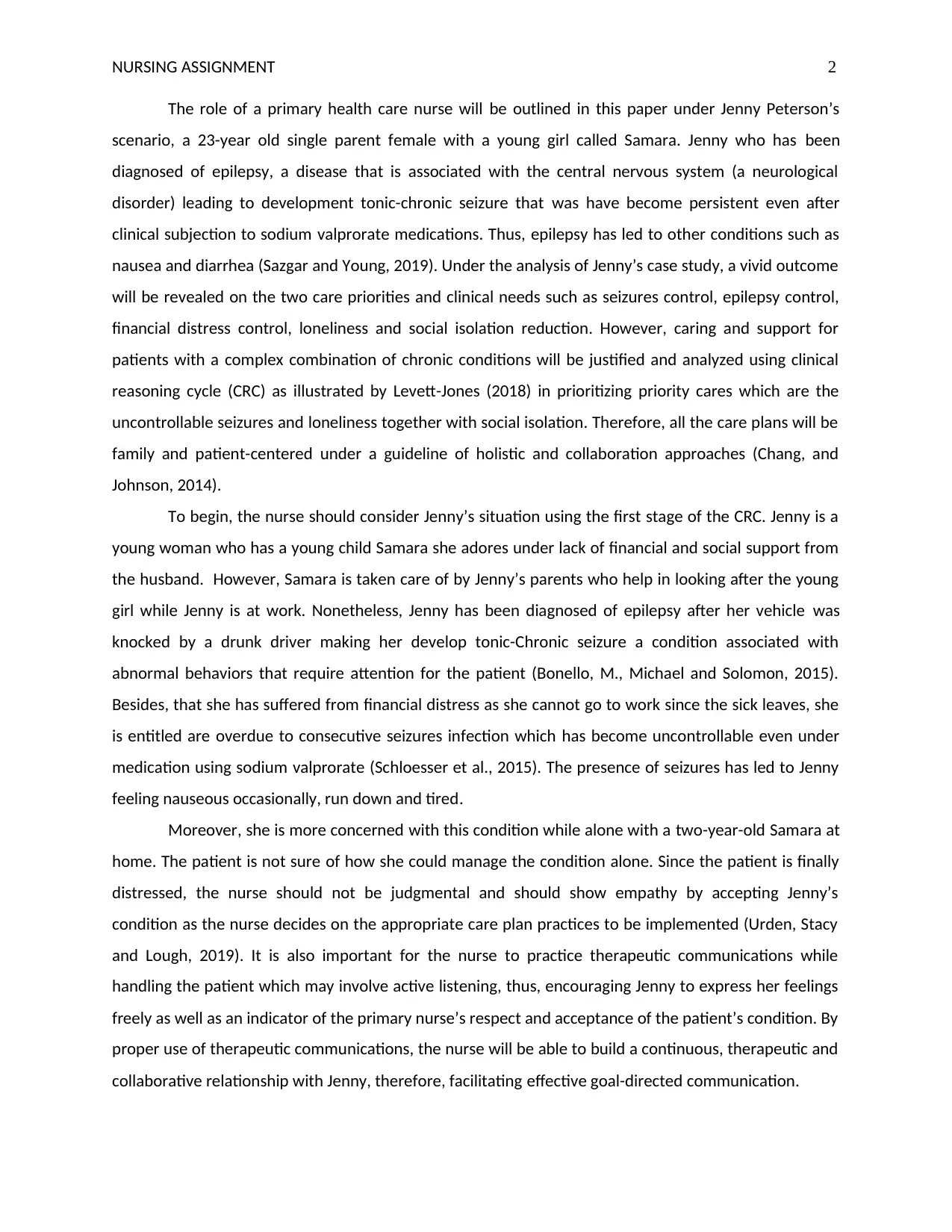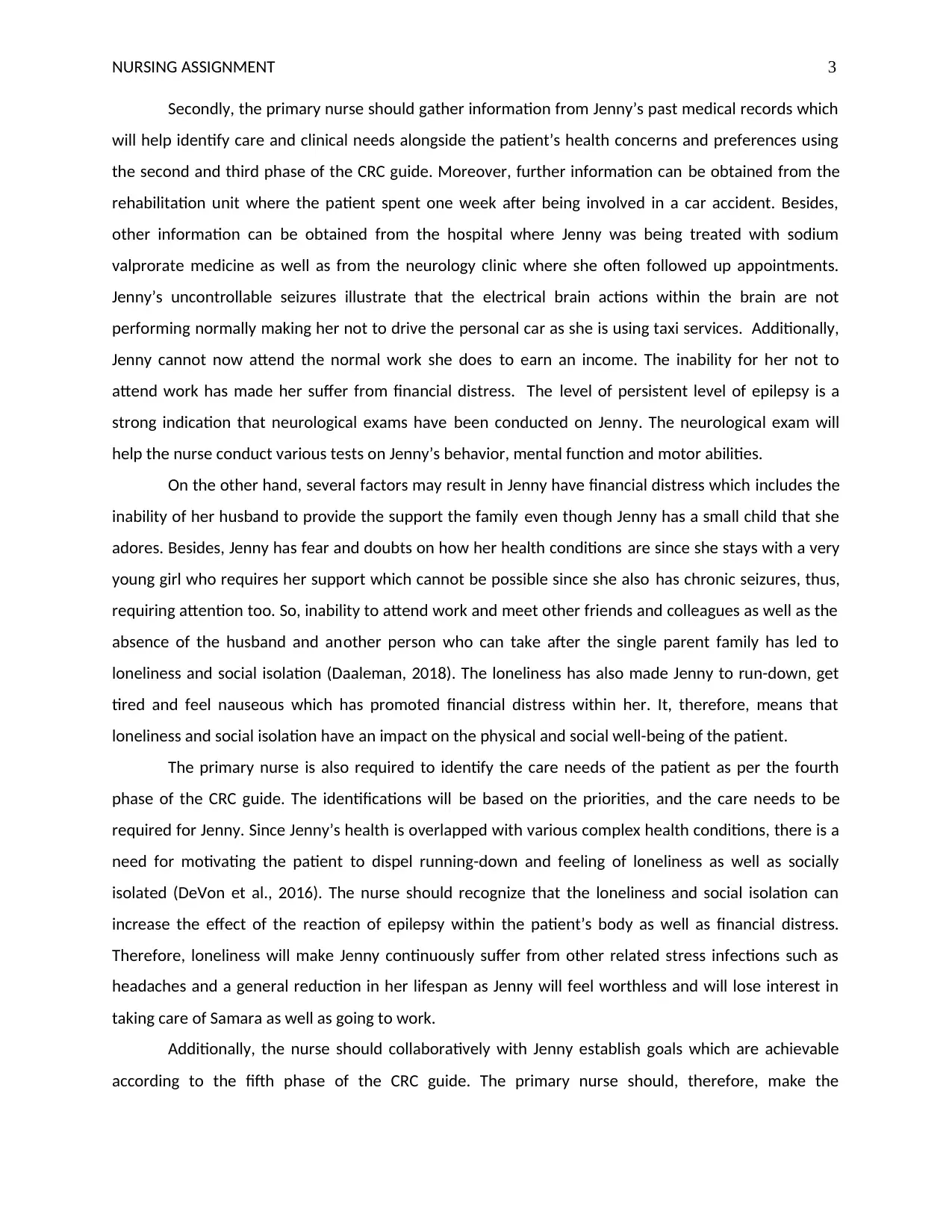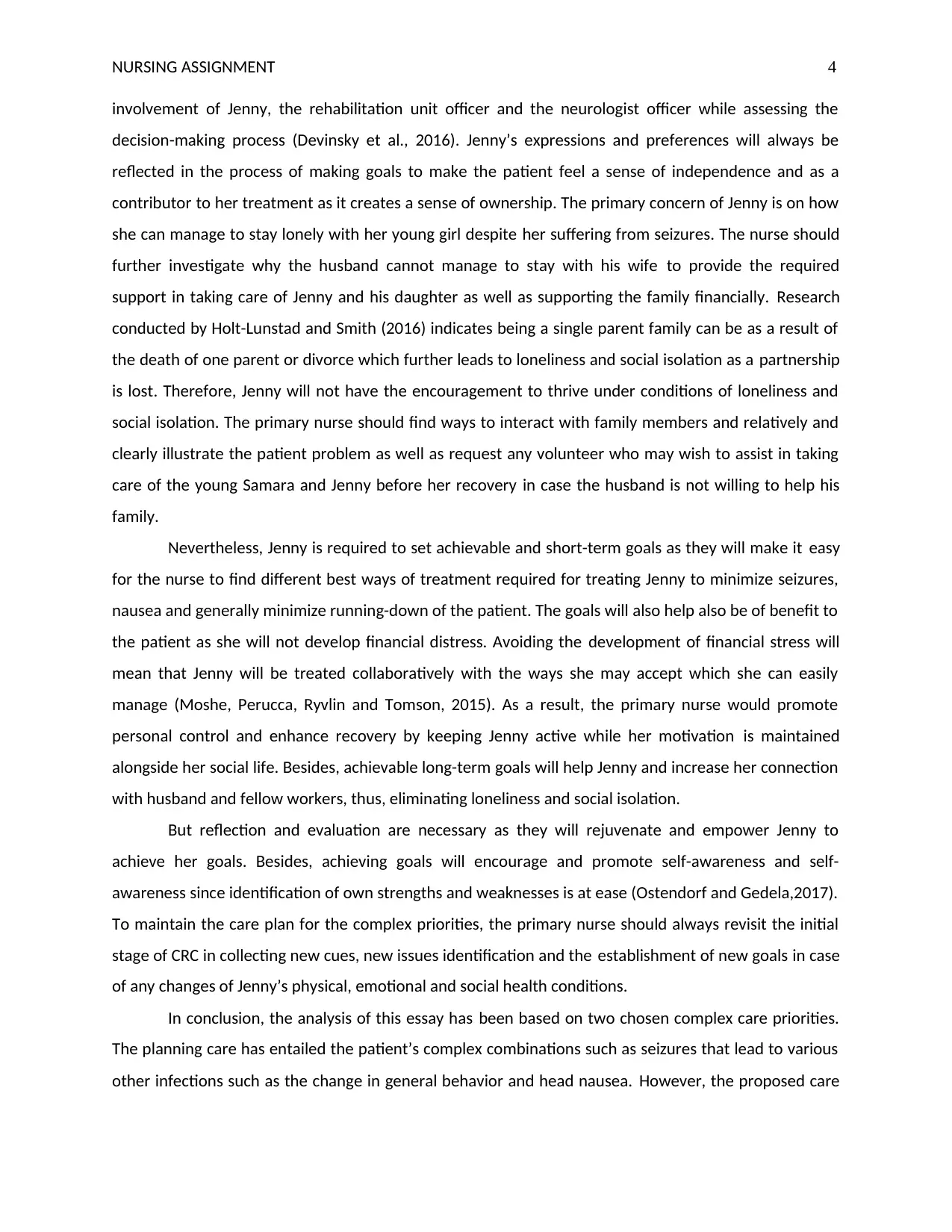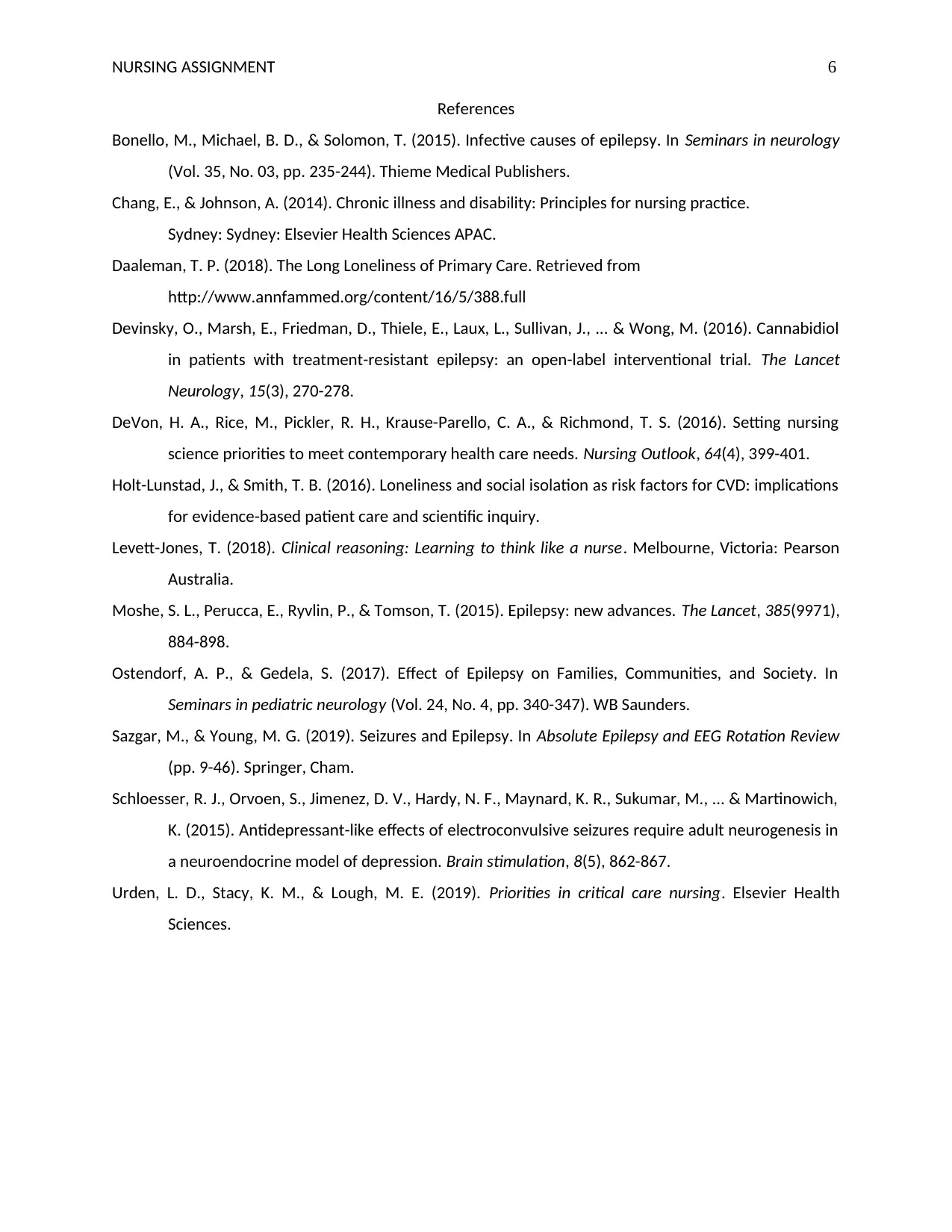NRSG366 Case Study: Epilepsy Care Priorities and Clinical Needs
VerifiedAdded on 2023/01/16
|6
|2274
|76
Case Study
AI Summary
This assignment is a case study analyzing the care of a 23-year-old single mother, Jenny Peterson, diagnosed with epilepsy. The paper outlines the role of a primary health care nurse, focusing on two key care priorities: seizure control and addressing loneliness/social isolation. The clinical reasoning cycle (CRC) is applied to justify the prioritization of care, considering the patient's complex health conditions, including epilepsy, financial distress, and the challenges of single parenthood. The assignment emphasizes holistic and collaborative approaches, highlighting the importance of therapeutic communication, gathering patient information, establishing achievable goals, and ongoing evaluation to enhance patient outcomes. The analysis incorporates relevant literature and emphasizes patient-centered care to improve Jenny's quality of life and manage her chronic conditions effectively. The case study also discusses the impact of epilepsy on the patient's physical, emotional, and social well-being and the need for ongoing support from healthcare professionals and family members.

Running head: NURSING ASSIGNMENT 1
Nursing Assignment
Student’s Name
Professor’s Name
Institution Affiliation
Date
Nursing Assignment
Student’s Name
Professor’s Name
Institution Affiliation
Date
Paraphrase This Document
Need a fresh take? Get an instant paraphrase of this document with our AI Paraphraser

NURSING ASSIGNMENT 2
The role of a primary health care nurse will be outlined in this paper under Jenny Peterson’s
scenario, a 23-year old single parent female with a young girl called Samara. Jenny who has been
diagnosed of epilepsy, a disease that is associated with the central nervous system (a neurological
disorder) leading to development tonic-chronic seizure that was have become persistent even after
clinical subjection to sodium valprorate medications. Thus, epilepsy has led to other conditions such as
nausea and diarrhea (Sazgar and Young, 2019). Under the analysis of Jenny’s case study, a vivid outcome
will be revealed on the two care priorities and clinical needs such as seizures control, epilepsy control,
financial distress control, loneliness and social isolation reduction. However, caring and support for
patients with a complex combination of chronic conditions will be justified and analyzed using clinical
reasoning cycle (CRC) as illustrated by Levett-Jones (2018) in prioritizing priority cares which are the
uncontrollable seizures and loneliness together with social isolation. Therefore, all the care plans will be
family and patient-centered under a guideline of holistic and collaboration approaches (Chang, and
Johnson, 2014).
To begin, the nurse should consider Jenny’s situation using the first stage of the CRC. Jenny is a
young woman who has a young child Samara she adores under lack of financial and social support from
the husband. However, Samara is taken care of by Jenny’s parents who help in looking after the young
girl while Jenny is at work. Nonetheless, Jenny has been diagnosed of epilepsy after her vehicle was
knocked by a drunk driver making her develop tonic-Chronic seizure a condition associated with
abnormal behaviors that require attention for the patient (Bonello, M., Michael and Solomon, 2015).
Besides, that she has suffered from financial distress as she cannot go to work since the sick leaves, she
is entitled are overdue to consecutive seizures infection which has become uncontrollable even under
medication using sodium valprorate (Schloesser et al., 2015). The presence of seizures has led to Jenny
feeling nauseous occasionally, run down and tired.
Moreover, she is more concerned with this condition while alone with a two-year-old Samara at
home. The patient is not sure of how she could manage the condition alone. Since the patient is finally
distressed, the nurse should not be judgmental and should show empathy by accepting Jenny’s
condition as the nurse decides on the appropriate care plan practices to be implemented (Urden, Stacy
and Lough, 2019). It is also important for the nurse to practice therapeutic communications while
handling the patient which may involve active listening, thus, encouraging Jenny to express her feelings
freely as well as an indicator of the primary nurse’s respect and acceptance of the patient’s condition. By
proper use of therapeutic communications, the nurse will be able to build a continuous, therapeutic and
collaborative relationship with Jenny, therefore, facilitating effective goal-directed communication.
The role of a primary health care nurse will be outlined in this paper under Jenny Peterson’s
scenario, a 23-year old single parent female with a young girl called Samara. Jenny who has been
diagnosed of epilepsy, a disease that is associated with the central nervous system (a neurological
disorder) leading to development tonic-chronic seizure that was have become persistent even after
clinical subjection to sodium valprorate medications. Thus, epilepsy has led to other conditions such as
nausea and diarrhea (Sazgar and Young, 2019). Under the analysis of Jenny’s case study, a vivid outcome
will be revealed on the two care priorities and clinical needs such as seizures control, epilepsy control,
financial distress control, loneliness and social isolation reduction. However, caring and support for
patients with a complex combination of chronic conditions will be justified and analyzed using clinical
reasoning cycle (CRC) as illustrated by Levett-Jones (2018) in prioritizing priority cares which are the
uncontrollable seizures and loneliness together with social isolation. Therefore, all the care plans will be
family and patient-centered under a guideline of holistic and collaboration approaches (Chang, and
Johnson, 2014).
To begin, the nurse should consider Jenny’s situation using the first stage of the CRC. Jenny is a
young woman who has a young child Samara she adores under lack of financial and social support from
the husband. However, Samara is taken care of by Jenny’s parents who help in looking after the young
girl while Jenny is at work. Nonetheless, Jenny has been diagnosed of epilepsy after her vehicle was
knocked by a drunk driver making her develop tonic-Chronic seizure a condition associated with
abnormal behaviors that require attention for the patient (Bonello, M., Michael and Solomon, 2015).
Besides, that she has suffered from financial distress as she cannot go to work since the sick leaves, she
is entitled are overdue to consecutive seizures infection which has become uncontrollable even under
medication using sodium valprorate (Schloesser et al., 2015). The presence of seizures has led to Jenny
feeling nauseous occasionally, run down and tired.
Moreover, she is more concerned with this condition while alone with a two-year-old Samara at
home. The patient is not sure of how she could manage the condition alone. Since the patient is finally
distressed, the nurse should not be judgmental and should show empathy by accepting Jenny’s
condition as the nurse decides on the appropriate care plan practices to be implemented (Urden, Stacy
and Lough, 2019). It is also important for the nurse to practice therapeutic communications while
handling the patient which may involve active listening, thus, encouraging Jenny to express her feelings
freely as well as an indicator of the primary nurse’s respect and acceptance of the patient’s condition. By
proper use of therapeutic communications, the nurse will be able to build a continuous, therapeutic and
collaborative relationship with Jenny, therefore, facilitating effective goal-directed communication.

NURSING ASSIGNMENT 3
Secondly, the primary nurse should gather information from Jenny’s past medical records which
will help identify care and clinical needs alongside the patient’s health concerns and preferences using
the second and third phase of the CRC guide. Moreover, further information can be obtained from the
rehabilitation unit where the patient spent one week after being involved in a car accident. Besides,
other information can be obtained from the hospital where Jenny was being treated with sodium
valprorate medicine as well as from the neurology clinic where she often followed up appointments.
Jenny’s uncontrollable seizures illustrate that the electrical brain actions within the brain are not
performing normally making her not to drive the personal car as she is using taxi services. Additionally,
Jenny cannot now attend the normal work she does to earn an income. The inability for her not to
attend work has made her suffer from financial distress. The level of persistent level of epilepsy is a
strong indication that neurological exams have been conducted on Jenny. The neurological exam will
help the nurse conduct various tests on Jenny’s behavior, mental function and motor abilities.
On the other hand, several factors may result in Jenny have financial distress which includes the
inability of her husband to provide the support the family even though Jenny has a small child that she
adores. Besides, Jenny has fear and doubts on how her health conditions are since she stays with a very
young girl who requires her support which cannot be possible since she also has chronic seizures, thus,
requiring attention too. So, inability to attend work and meet other friends and colleagues as well as the
absence of the husband and another person who can take after the single parent family has led to
loneliness and social isolation (Daaleman, 2018). The loneliness has also made Jenny to run-down, get
tired and feel nauseous which has promoted financial distress within her. It, therefore, means that
loneliness and social isolation have an impact on the physical and social well-being of the patient.
The primary nurse is also required to identify the care needs of the patient as per the fourth
phase of the CRC guide. The identifications will be based on the priorities, and the care needs to be
required for Jenny. Since Jenny’s health is overlapped with various complex health conditions, there is a
need for motivating the patient to dispel running-down and feeling of loneliness as well as socially
isolated (DeVon et al., 2016). The nurse should recognize that the loneliness and social isolation can
increase the effect of the reaction of epilepsy within the patient’s body as well as financial distress.
Therefore, loneliness will make Jenny continuously suffer from other related stress infections such as
headaches and a general reduction in her lifespan as Jenny will feel worthless and will lose interest in
taking care of Samara as well as going to work.
Additionally, the nurse should collaboratively with Jenny establish goals which are achievable
according to the fifth phase of the CRC guide. The primary nurse should, therefore, make the
Secondly, the primary nurse should gather information from Jenny’s past medical records which
will help identify care and clinical needs alongside the patient’s health concerns and preferences using
the second and third phase of the CRC guide. Moreover, further information can be obtained from the
rehabilitation unit where the patient spent one week after being involved in a car accident. Besides,
other information can be obtained from the hospital where Jenny was being treated with sodium
valprorate medicine as well as from the neurology clinic where she often followed up appointments.
Jenny’s uncontrollable seizures illustrate that the electrical brain actions within the brain are not
performing normally making her not to drive the personal car as she is using taxi services. Additionally,
Jenny cannot now attend the normal work she does to earn an income. The inability for her not to
attend work has made her suffer from financial distress. The level of persistent level of epilepsy is a
strong indication that neurological exams have been conducted on Jenny. The neurological exam will
help the nurse conduct various tests on Jenny’s behavior, mental function and motor abilities.
On the other hand, several factors may result in Jenny have financial distress which includes the
inability of her husband to provide the support the family even though Jenny has a small child that she
adores. Besides, Jenny has fear and doubts on how her health conditions are since she stays with a very
young girl who requires her support which cannot be possible since she also has chronic seizures, thus,
requiring attention too. So, inability to attend work and meet other friends and colleagues as well as the
absence of the husband and another person who can take after the single parent family has led to
loneliness and social isolation (Daaleman, 2018). The loneliness has also made Jenny to run-down, get
tired and feel nauseous which has promoted financial distress within her. It, therefore, means that
loneliness and social isolation have an impact on the physical and social well-being of the patient.
The primary nurse is also required to identify the care needs of the patient as per the fourth
phase of the CRC guide. The identifications will be based on the priorities, and the care needs to be
required for Jenny. Since Jenny’s health is overlapped with various complex health conditions, there is a
need for motivating the patient to dispel running-down and feeling of loneliness as well as socially
isolated (DeVon et al., 2016). The nurse should recognize that the loneliness and social isolation can
increase the effect of the reaction of epilepsy within the patient’s body as well as financial distress.
Therefore, loneliness will make Jenny continuously suffer from other related stress infections such as
headaches and a general reduction in her lifespan as Jenny will feel worthless and will lose interest in
taking care of Samara as well as going to work.
Additionally, the nurse should collaboratively with Jenny establish goals which are achievable
according to the fifth phase of the CRC guide. The primary nurse should, therefore, make the
⊘ This is a preview!⊘
Do you want full access?
Subscribe today to unlock all pages.

Trusted by 1+ million students worldwide

NURSING ASSIGNMENT 4
involvement of Jenny, the rehabilitation unit officer and the neurologist officer while assessing the
decision-making process (Devinsky et al., 2016). Jenny’s expressions and preferences will always be
reflected in the process of making goals to make the patient feel a sense of independence and as a
contributor to her treatment as it creates a sense of ownership. The primary concern of Jenny is on how
she can manage to stay lonely with her young girl despite her suffering from seizures. The nurse should
further investigate why the husband cannot manage to stay with his wife to provide the required
support in taking care of Jenny and his daughter as well as supporting the family financially. Research
conducted by Holt-Lunstad and Smith (2016) indicates being a single parent family can be as a result of
the death of one parent or divorce which further leads to loneliness and social isolation as a partnership
is lost. Therefore, Jenny will not have the encouragement to thrive under conditions of loneliness and
social isolation. The primary nurse should find ways to interact with family members and relatively and
clearly illustrate the patient problem as well as request any volunteer who may wish to assist in taking
care of the young Samara and Jenny before her recovery in case the husband is not willing to help his
family.
Nevertheless, Jenny is required to set achievable and short-term goals as they will make it easy
for the nurse to find different best ways of treatment required for treating Jenny to minimize seizures,
nausea and generally minimize running-down of the patient. The goals will also help also be of benefit to
the patient as she will not develop financial distress. Avoiding the development of financial stress will
mean that Jenny will be treated collaboratively with the ways she may accept which she can easily
manage (Moshe, Perucca, Ryvlin and Tomson, 2015). As a result, the primary nurse would promote
personal control and enhance recovery by keeping Jenny active while her motivation is maintained
alongside her social life. Besides, achievable long-term goals will help Jenny and increase her connection
with husband and fellow workers, thus, eliminating loneliness and social isolation.
But reflection and evaluation are necessary as they will rejuvenate and empower Jenny to
achieve her goals. Besides, achieving goals will encourage and promote self-awareness and self-
awareness since identification of own strengths and weaknesses is at ease (Ostendorf and Gedela,2017).
To maintain the care plan for the complex priorities, the primary nurse should always revisit the initial
stage of CRC in collecting new cues, new issues identification and the establishment of new goals in case
of any changes of Jenny’s physical, emotional and social health conditions.
In conclusion, the analysis of this essay has been based on two chosen complex care priorities.
The planning care has entailed the patient’s complex combinations such as seizures that lead to various
other infections such as the change in general behavior and head nausea. However, the proposed care
involvement of Jenny, the rehabilitation unit officer and the neurologist officer while assessing the
decision-making process (Devinsky et al., 2016). Jenny’s expressions and preferences will always be
reflected in the process of making goals to make the patient feel a sense of independence and as a
contributor to her treatment as it creates a sense of ownership. The primary concern of Jenny is on how
she can manage to stay lonely with her young girl despite her suffering from seizures. The nurse should
further investigate why the husband cannot manage to stay with his wife to provide the required
support in taking care of Jenny and his daughter as well as supporting the family financially. Research
conducted by Holt-Lunstad and Smith (2016) indicates being a single parent family can be as a result of
the death of one parent or divorce which further leads to loneliness and social isolation as a partnership
is lost. Therefore, Jenny will not have the encouragement to thrive under conditions of loneliness and
social isolation. The primary nurse should find ways to interact with family members and relatively and
clearly illustrate the patient problem as well as request any volunteer who may wish to assist in taking
care of the young Samara and Jenny before her recovery in case the husband is not willing to help his
family.
Nevertheless, Jenny is required to set achievable and short-term goals as they will make it easy
for the nurse to find different best ways of treatment required for treating Jenny to minimize seizures,
nausea and generally minimize running-down of the patient. The goals will also help also be of benefit to
the patient as she will not develop financial distress. Avoiding the development of financial stress will
mean that Jenny will be treated collaboratively with the ways she may accept which she can easily
manage (Moshe, Perucca, Ryvlin and Tomson, 2015). As a result, the primary nurse would promote
personal control and enhance recovery by keeping Jenny active while her motivation is maintained
alongside her social life. Besides, achievable long-term goals will help Jenny and increase her connection
with husband and fellow workers, thus, eliminating loneliness and social isolation.
But reflection and evaluation are necessary as they will rejuvenate and empower Jenny to
achieve her goals. Besides, achieving goals will encourage and promote self-awareness and self-
awareness since identification of own strengths and weaknesses is at ease (Ostendorf and Gedela,2017).
To maintain the care plan for the complex priorities, the primary nurse should always revisit the initial
stage of CRC in collecting new cues, new issues identification and the establishment of new goals in case
of any changes of Jenny’s physical, emotional and social health conditions.
In conclusion, the analysis of this essay has been based on two chosen complex care priorities.
The planning care has entailed the patient’s complex combinations such as seizures that lead to various
other infections such as the change in general behavior and head nausea. However, the proposed care
Paraphrase This Document
Need a fresh take? Get an instant paraphrase of this document with our AI Paraphraser

NURSING ASSIGNMENT 5
plan and analysis for the two complex care priorities has been actively enhanced through the use of CRC,
holistic, person centered-care and principles of collaboration which has justified and addressed the
complex care priorities. These include the chronic seizures and Jenny’s loneliness alongside social
isolation as he lives alone with a young two-year-old girl and worries about her life with seizures along
with her daughter. Thus, in collaboration with Jenny and the rehabilitation unit team, all care has been
planned to attain and increase the benefits of the patient’s health care.
plan and analysis for the two complex care priorities has been actively enhanced through the use of CRC,
holistic, person centered-care and principles of collaboration which has justified and addressed the
complex care priorities. These include the chronic seizures and Jenny’s loneliness alongside social
isolation as he lives alone with a young two-year-old girl and worries about her life with seizures along
with her daughter. Thus, in collaboration with Jenny and the rehabilitation unit team, all care has been
planned to attain and increase the benefits of the patient’s health care.

NURSING ASSIGNMENT 6
References
Bonello, M., Michael, B. D., & Solomon, T. (2015). Infective causes of epilepsy. In Seminars in neurology
(Vol. 35, No. 03, pp. 235-244). Thieme Medical Publishers.
Chang, E., & Johnson, A. (2014). Chronic illness and disability: Principles for nursing practice.
Sydney: Sydney: Elsevier Health Sciences APAC.
Daaleman, T. P. (2018). The Long Loneliness of Primary Care. Retrieved from
http://www.annfammed.org/content/16/5/388.full
Devinsky, O., Marsh, E., Friedman, D., Thiele, E., Laux, L., Sullivan, J., ... & Wong, M. (2016). Cannabidiol
in patients with treatment-resistant epilepsy: an open-label interventional trial. The Lancet
Neurology, 15(3), 270-278.
DeVon, H. A., Rice, M., Pickler, R. H., Krause-Parello, C. A., & Richmond, T. S. (2016). Setting nursing
science priorities to meet contemporary health care needs. Nursing Outlook, 64(4), 399-401.
Holt-Lunstad, J., & Smith, T. B. (2016). Loneliness and social isolation as risk factors for CVD: implications
for evidence-based patient care and scientific inquiry.
Levett-Jones, T. (2018). Clinical reasoning: Learning to think like a nurse. Melbourne, Victoria: Pearson
Australia.
Moshe, S. L., Perucca, E., Ryvlin, P., & Tomson, T. (2015). Epilepsy: new advances. The Lancet, 385(9971),
884-898.
Ostendorf, A. P., & Gedela, S. (2017). Effect of Epilepsy on Families, Communities, and Society. In
Seminars in pediatric neurology (Vol. 24, No. 4, pp. 340-347). WB Saunders.
Sazgar, M., & Young, M. G. (2019). Seizures and Epilepsy. In Absolute Epilepsy and EEG Rotation Review
(pp. 9-46). Springer, Cham.
Schloesser, R. J., Orvoen, S., Jimenez, D. V., Hardy, N. F., Maynard, K. R., Sukumar, M., ... & Martinowich,
K. (2015). Antidepressant-like effects of electroconvulsive seizures require adult neurogenesis in
a neuroendocrine model of depression. Brain stimulation, 8(5), 862-867.
Urden, L. D., Stacy, K. M., & Lough, M. E. (2019). Priorities in critical care nursing. Elsevier Health
Sciences.
References
Bonello, M., Michael, B. D., & Solomon, T. (2015). Infective causes of epilepsy. In Seminars in neurology
(Vol. 35, No. 03, pp. 235-244). Thieme Medical Publishers.
Chang, E., & Johnson, A. (2014). Chronic illness and disability: Principles for nursing practice.
Sydney: Sydney: Elsevier Health Sciences APAC.
Daaleman, T. P. (2018). The Long Loneliness of Primary Care. Retrieved from
http://www.annfammed.org/content/16/5/388.full
Devinsky, O., Marsh, E., Friedman, D., Thiele, E., Laux, L., Sullivan, J., ... & Wong, M. (2016). Cannabidiol
in patients with treatment-resistant epilepsy: an open-label interventional trial. The Lancet
Neurology, 15(3), 270-278.
DeVon, H. A., Rice, M., Pickler, R. H., Krause-Parello, C. A., & Richmond, T. S. (2016). Setting nursing
science priorities to meet contemporary health care needs. Nursing Outlook, 64(4), 399-401.
Holt-Lunstad, J., & Smith, T. B. (2016). Loneliness and social isolation as risk factors for CVD: implications
for evidence-based patient care and scientific inquiry.
Levett-Jones, T. (2018). Clinical reasoning: Learning to think like a nurse. Melbourne, Victoria: Pearson
Australia.
Moshe, S. L., Perucca, E., Ryvlin, P., & Tomson, T. (2015). Epilepsy: new advances. The Lancet, 385(9971),
884-898.
Ostendorf, A. P., & Gedela, S. (2017). Effect of Epilepsy on Families, Communities, and Society. In
Seminars in pediatric neurology (Vol. 24, No. 4, pp. 340-347). WB Saunders.
Sazgar, M., & Young, M. G. (2019). Seizures and Epilepsy. In Absolute Epilepsy and EEG Rotation Review
(pp. 9-46). Springer, Cham.
Schloesser, R. J., Orvoen, S., Jimenez, D. V., Hardy, N. F., Maynard, K. R., Sukumar, M., ... & Martinowich,
K. (2015). Antidepressant-like effects of electroconvulsive seizures require adult neurogenesis in
a neuroendocrine model of depression. Brain stimulation, 8(5), 862-867.
Urden, L. D., Stacy, K. M., & Lough, M. E. (2019). Priorities in critical care nursing. Elsevier Health
Sciences.
⊘ This is a preview!⊘
Do you want full access?
Subscribe today to unlock all pages.

Trusted by 1+ million students worldwide
1 out of 6
Related Documents
Your All-in-One AI-Powered Toolkit for Academic Success.
+13062052269
info@desklib.com
Available 24*7 on WhatsApp / Email
![[object Object]](/_next/static/media/star-bottom.7253800d.svg)
Unlock your academic potential
Copyright © 2020–2025 A2Z Services. All Rights Reserved. Developed and managed by ZUCOL.




